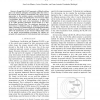241
Voted
ADHOC
2011
14 years 7 months ago
2011
One of the intrinsic problems of mobility in wireless networks is the discovery of mobile nodes. A widely used solution for this problem is to use different variations of beacons, ...
131
Voted
TPDS
2008
15 years 20 days ago
2008
The localization of sensor nodes is a fundamental problem in sensor networks and can be implemented using powerful and expensive beacons. Beacons, the fewer the better, can acquire...
103
Voted
WICON
2008
15 years 2 months ago
2008
In a tree-based ZigBee network, ZigBee routers (ZRs) must schedule their beacon transmission times to avoid beacon collisions. The beacon schedule determines packet delivery laten...
104
Voted
ICRA
2002
IEEE
15 years 5 months ago
2002
IEEE
This paper presents methods of localization using cooperating landmarks (beacons) that provide the ability to measure range only. Recent advances in radio frequency technology mak...
115
Voted
MIDDLEWARE
2004
Springer
15 years 6 months ago
2004
Springer
The Internet provides a wealth of useful information in a vast number of dynamic information sources, but it is difficult to determine which sources are useful for a given query. ...
109
Voted
DBISP2P
2004
Springer
15 years 6 months ago
2004
Springer
We present the InfoBeacons system, in which a peer-to-peer network of beacons cooperates to route queries to the best information sources. The routing in our system uses techniques...
118
click to vote
ISMAR
2006
IEEE
15 years 6 months ago
2006
IEEE
We describe and evaluate a new tracking concept for outdoor Augmented Reality. A few mobile beacons added to the environment correct errors in head-worn inertial and GPS sensors. ...
100
Voted
VTC
2007
IEEE
15 years 7 months ago
2007
IEEE
—Localization is a critical issue in wireless sensor networks. In most localization schemes, there are beacons being placed as references to determine the positions of objects or...
103
Voted
ICC
2007
IEEE
15 years 7 months ago
2007
IEEE
—The localization of the sensor node is a fundamental problem in sensor networks and can be implemented using powerful and expensive beacons. Beacons, the fewer the better, can a...
ICRA
2008
IEEE
15 years 7 months ago
2008
IEEE
— Range-Only SLAM represents a difficult problem due to the inherent ambiguity of localizing either the robot or the beacons from distance measurements only. Most previous appro...

